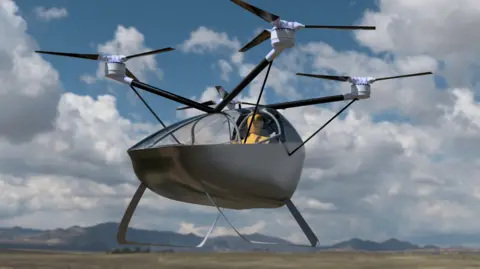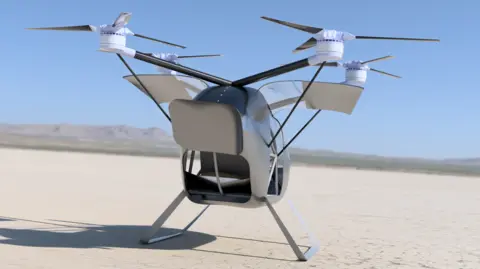University designs new emergency aircraft
 CraneAERO
CraneAEROResearchers have devised a new class of vertical take-off aircraft to help first responders reach emergency situations more quickly.
Designed by a team at Cranfield University, Bedfordshire, the electric Vertical Take-Off and Landing aircraft - or eVTOL - could reach places that are hazardous or difficult to access by helicopter or ambulance.
It will use AI and advanced navigation systems for real-time missions.
CRANE - Cranfield Rapid Aerial Network for Emergency - has been recognised for its strengths in safety, performance, feasibility and technical innovation.
"We envision our eVTOL as a game-changer in emergency response," said Muhammad Haad Shaikh, a PhD researcher in hybrid aerospace propulsion and an aerospace systems engineer who serves as CraneAERO's captain and project manager.
"In situations where every second counts, our flyer is built to bridge the gap between traditional emergency response and next-generation aerial mobility, providing fast, reliable, and autonomous solutions for search and rescue (SAR), disaster relief, and medical evacuation."
 CraneAERO
CraneAEROThe CraneAERO team, which includes staff, students and researchers at the university, is taking part in a three-year global competition - the GoAero Challenge.
It is one of only 11 global winners from more than 200 competing teams in Stage One - and the only UK team selected.
Its design has made it through to Stage Two, which will involve building and demonstrating a sub-scale prototype by September 2025.
Stage Three requires a full-scale build and live flight testing in challenging environments.
"Cranfield has unique facilities including our own airport, our own aircraft, and the latest aerospace technologies across the spectrum, including those in propulsion, sensors, controls, autonomy, and AI, and design materials," said Dr Dmitry Ignatyev, senior lecturer in Flight Dynamics and Control.
"All this is how we teach our students - a combination of academic training and hands-on industry experiences.
"Our GoAERO endeavour shows this works well for our students."
Follow Beds, Herts and Bucks news on BBC Sounds, Facebook, Instagram and X.
